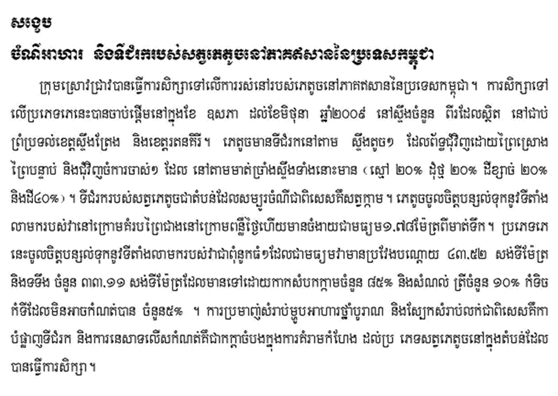IUCN/SSC Otter Specialist Group Bulletin

|
IUCN/SCC Otter Specialist Group Bulletin Volume 27 Issue 1 Pages 1 - 57 (January 2010) Citation: Hon, N., Neak, P., Khov, V. and Cheat, V. (2010). Food And Habitat Of Asian Small-Clawed Otters In Northeastern Cambodia. IUCN Otter Spec. Group Bull. 27 (1): 12 – 23 Food And Habitat Of Asian Small-Clawed Otters In Northeastern Cambodia Naven Hon1, Phearoom Neak2, Vengsong Khov3 and Vichet Cheat4 1Tonle Sap
Program Officer, Conservation International, Phnom Penh, Cambodia
and student at Royal University of Agriculture, Faculty of Forestry
Science, Phnom Penh, Cambodia, |



 |
|
Abstract: We established the existence of Asian small-clawed otters, Aonyx cinereus, in northeastern Cambodia. The study was conducted between May to June 2009, at two fresh water streams located on the border between Stung Treng and Ratanakiri province, northeastern Cambodia. Asian small-clawed otters’ main habitat appears to be small fresh streams surrounded by evergreen-forest, secondary-forest or abandoned farmland, with shoreline vegetation (grass 20%, rock 20%, sand 20%, and soil 40%), where it is rich in food sources, especially crabs. Asian small-clawed otters prefer to produce their sprainting sites under canopy cover rather than the open sky, and situated their spraint an average of 1.78 m from water. This species seems to produce their sprainting sites in large piles (33.11 cm average in width and 43.52 cm in length), which consisted of crabs 85%, and fish 10%, unidentifiable debris 5%. Hunting for meat, traditional medicine, and skins for trade as well as habitat disturbance and over fishing are the main threats to the population of Asian small-clawed otter in the study area. |
| Keywords: cinereus, threat, skin trade, hunting, ecology, diets |
| Française | Español | Khmer |
INTRODUCTION
Four species of otters historically occurred in Cambodia: the hairy-nosed otter Lutra sumatrana, the smooth-coated otter Lutrogale perspicillata, the Asian small-clawed otter Aonyx cinereus, and the Eurasian otter Lutra lutra (Poole, 2003). Recently, hairy-nosed otters have been found in a few locations in Cambodia: Tonle Sap Great Lake (Olsson et al., 2007), the Cardamom Mountains (Wright et al., 2008), and coastal areas of Koh Kong province (Hon and Dong, 2008). The smooth-coated otter is found in nearly all parts of Cambodia. There are no current reliable reports of Eurasian otters in Cambodia.
The Asian small-clawed otter is listed as a Vulnerable Species by the IUCN Otter Specialist Group Red List Authority because of an inferred future population decline due to habitat loss and exploitation (Hussain and de Silva, 2008). This species was historically found in many countries such as the Philippines, Indonesia, southern India, Sri Lanka, Peninsular Malaysia, Thailand (Harris, 1968), Bangladesh, Bhutan, Brunei, South China, Hong Kong, Lao PDR, Nepal, Singapore, and Vietnam (Lekagul and McNeely, 1977; Medway, 1969). There have been no reports or reliable information on the Asian small-clawed otter in Cambodia for long time, and there is a great deal of concern about the decline of populations of this species, but recent unpublished work found evidence of their existence in northeastern Cambodia (Hon, 2008).
Asian small-clawed otters are the smallest otters in the world (Kanchanasaka et al., 1998). They usually live in small family groups of about 4-12 members. Their food includes shrimps, crabs, some molluscs, and fish and mostly inhabits streams, lakes, swamps and various other wetlands (Kruuk, 1995; Kanchanasaka, 1997).
In this study we focuses on two streams, Kasap and Tankin, located on the border between Stung Treng and Ratanakiri provinces in northeastern Cambodia. Our aim was to identify their main habitat, diet, and the threats they face. We hope that this work will be useful for Asian small-clawed otter conservation in general, and specifically for the Conservation International Otter Conservation Project in Cambodia.
STUDY AREA
This study was conducted along the borders of Stung Treng and Ratanakiri Provinces. Interviews were conducted in three villages: I-Tub, Pakea, and Kang Nouk. The Veun Sai district is well known as having a rich variety of flora and fauna and religious cultural heritage, and is populated by Khmer and many ethnic minorities including Kreng, Lao, and Chinese. The town of Veun Sai is located in the district, approximately 38 km north by road of Banlung town, and is on the Sesan River. It is contiguous with Virachey National Park: one of the priority areas for both fauna and flora conservation in Southeast Asia. The major vegetation types in this area (Veun Sai District) are: grassland (36%), non forest (34%), semi-evergreen forest (24%), evergreen-forest (4%) and deciduous forest (2%) (Forestry Administration, 2006). The study started where the Kasap and Tankin streams merged with each other (Figure 1).
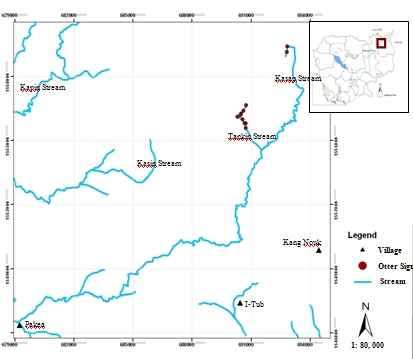 |
| Figure
1. Location of study sites, northeastern Cambodia. (click for larger version) |
Kasap (693197/1558670) stream is a long watercourse which flows from the mountains of Virachey National Park through to the Sekong River, Stung Treng Province. The stream is rich in fisheries resources and most parts are surrounded by evergreen-forest.
Tankin (690622/1556384) is a small seasonal stream which only flows continuously in the wet season (April to October). Most parts of this stream are surrounded by old farms (shifting cultivation) of indigenous people who live near/in those forested areas.
During the survey we found considerable evidence of crab holes and some crabs and fish were seen directly along the stream. There are two small fresh water streams connected with the Kasap stream, Kasin and Kapin, located downstream from Pakea village. These streams were not surveyed during the study, but were mentioned in the interviews with local people.
METHOD
Interviews
Interviews were conducted in three villages: (Figure 1). Sixty families were chosen interview. People were selected based on their experience: fishermen, hunters, wildlife middlemen, rangers and/or people who spend most time in the forest. These people were interviewed by using a pre-designed structured questionnaire. The interviews aimed to assess which otter species were present, their past and present distribution and the abundance of these species. Interviews also assessed any changes that maybe impacted on the otter’s habitat, local threats to otters, demand for the trade of otters and otter’s parts and other information as needed.
Transect Surveys
The unmistakable Asian small-clawed otter footprints are small, rounded, with long fingers very clearly visible, and without any claw marks; spraints are large and full with crabs (Kruuk et al., 1993; Kruuk, 2006). Two lines transect, to search for otter signs such as spraints, footprints, grooming sites, and sprainting sites, were walked along the two streams, one of 3,092 meters on Kasap stream and other of 1,495 meters on Tankin stream (Figure 1). These lengths were determined depending on the local conditions. The water levels can be very deep and there is thick forest that cannot be walked across. Whenever, otter signs were found, the spraints were measured and collected for prey analysis by putting them into small plastic boxes, grooming sites were measured and a plaster cast of footprint were made for species identification. After the surveys, habitat assessments were conducted. Plot sizes of 5 x 5 m (25m2) were laid around the otter signs. These plots were intensively searched for additional otter signs, and the following habitat assessment data were collected: water depth, river width, tree diameter by using measure tape. Water current and habitat types were recorded by using direct observation. Forest canopy was evaluated using a finger hole in A4 paper to evaluate the percentage between canopy cover and open sky. Ground cover was recorded step by step around the habitat assessment area, one step being recorded as one item (e.g. step one might be grass and step two could be sand, soil or litter. Ten steps were done per plot. Tree species around the habitat assessment areas were identified by using local guides. Tree height was measured using Suunto height meters.
Various methods such as direct observation (Kanchanasaka, 2001) and taking notes were used for recording data on otter threats in the study areas such snares, traps, and illegal fishing activities, human and dog footprints were found at the study sites. And other evidence such wildlife-shops were observed and recorded as indicating potential threats to otters.
Camera trapping
Camera traps were set in those areas where otter signs were found. Four camera traps were set in front of sprainting sites and one was set in front of a grooming site. The results from camera traps were intended to be used for species identification and document human disturbance to otters in those areas. Two Cam Trakkers were set for day and night time photography, set for 24 hours actively with a camera delay of 10 seconds, producing one photo every 10 seconds. Three Reconyx cameras were used also set for 24 hours actively (Nguyen et al, 2002), and with a camera delay of 10 seconds, producing three photos every 10 seconds.
Five camera traps were set up at five difference sites representing approximately nearly the same habitats, and those camera traps had been setting for the whole 20 days period. Because the study period was during the heavy rainy season, (Cambodian rainy season is in April to October) and these streams water levels can rise very quickly, we set the cameras high above water level in order to avoid water damage (Figure 2).
 |
| Figure 2.Diagram showing the height from the ground and distance from otter signs that camera traps were placed in the rainy season in the study areas. |
Procedure for Spraint Analysis
Spraint analyses have been used to determine the diet of wild otters (e.g. Webb, 1975; Clavero et al, 2004). Spraint composition was analyzed in order to find out the main diet of Asian small-clawed otter in the study sites. All spraints were cleaned with water in a box (length 47 cm and width 36cm) using a Petri dish to separate the litter from the spraint items (Anoop and Hussain, 2004). After this, they were placed on clean paper and dried out of direct light, then transferred to labeled small boxes. Spraints were separated by prey species (crap, fish, and unidentified debris) and each species were weighed in order to calculate as a percentage of composition.
RESULTS
Interviews
Sixty households were interviewed in three villages: I-Tub, Pakea, and Kang Nak. Each household chose one person for interview. Their main livelihoods are shown in Table 1. Nearly all interviewees usually see otters directly both in the rainy season and dry season. Eighty seven percent claimed that they used to see otters, especially when they go fishing and collecting non-timber forest products in areas where otters live. Moreover, the results showed that 52% have seen otters in the morning, 17% in the afternoon, 8% in the evening, and 8% at night. Otters were most frequently seen in Kasap stream, with 68% of interviewees having sighted otters there, compared with 13% in the Kasin stream.
|
|
|
| Table 1: The local People: livelihood categories | |
|
|
|
| Livelihood | Percentage (%) |
| Farmer and Fishing | 53 |
| Farmer and Hunter | 42 |
| Mainly Farmer | 5 |
|
|
|
Habitat Types
Records from tracks (hind-foot 4 cm and fore-foot 3cm), spraints, and direct observations have shown that Asian small-clawed otters occur in the surveyed areas both at Kasap and Tankin streams. Asian small-clawed otters were found in small fresh water streams in the study sites, with an average stream width of 5.72 m, slow water current, water depth of 51.18 cm, and shoreline composition of grass 20%, rock 20%, sand 20%, and soil 40%. There were 30 tree species found around the sprainting sites of Asian small-clawed otter, dominant species are shown in Table 2.
|
|
|
| Table 2: Percentage tree species found at the spraint sites of small clawed otter | |
|
|
|
| Tree Species | Percentage (%) |
|
Bridelia ovata |
16 |
|
Homonoia riparia |
10 |
|
Barringtonia acuiangula |
8 |
|
Other 27 species |
66 |
|
|
|
Spraint and Sprainting sites
Twelve sprainting sites were collected over the 14 days between May to June 2009: this period is completely within the wet season in northeastern Cambodia .Most spraints were found on the rock, sand, and soil (Figure 3), with a strong preference for sand. Sixty seven percent of spraints were found under the canopy cover and 33% were found under the open sky. Most of the sprainting sites were situated in an average of 1.78 m from the water edge (standard deviation 0.88, n=11). The large piles of sprainting sites of Asian small-clawed otter were found in the study sites (width in an average 33.11 cm and length in an average 43.52 cm). Spraints were easily damaged by rain, but were grey white in color when fresh (Figure 4), did not have a strong smell, and where dominated by crab remains. In the study sites, relative densities of sprainting sites were 386.56 m/sprainting site at Kasap stream and 166.16m/sprainting site at Tankin stream.
 |
| Figure 3.Substrate of Asian small-clawed otter deposit their spraintting site in the study areas |
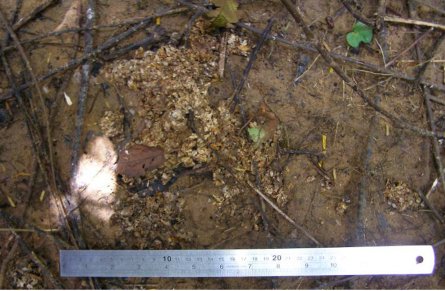 |
| Figure 4.Substrate of Asian small-clawed otter deposit their spraintting site in the study areas |
Spraint composition
The result from spraint analysis has shown that crab was the main prey for Asian-small-clawed otter in the study sites (Figure 5). However, crab and fish species could not identify.
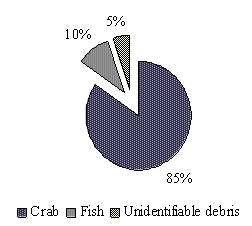 |
| Figure 5.Composition of Asian small-clawed otter diet |
Threats
The overall otter numbers in Veun Sai district appear to have been reduced significantly when compared to the past population, according to 70% of the interviewees. For example, from 1990 to 2009 there were 21 otters killed in this area alone (Figure 6). Forty five percent of local people claimed that the Chinese people who live in the Chinese village at Veun Sia town and wildlife middlemen came to tell indigenous people in villages to hunt wildlife including otters for them. Local wildlife traders bought otter skins at a very high price; small skins for 10,000-40,000 Riel/skin and large skins at 60,000-150,000 Riel/skin (1USD=4100 Riel)
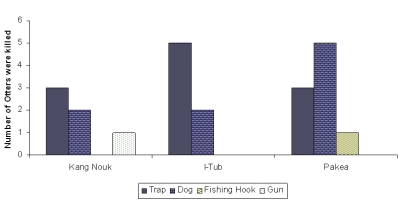 |
| Figure 6. Numbers of otters were killed in 1990-2009 at I-Tub, Pakea, and Kang Nak village, Veun Sai district, Ratanakiri province. |
Although there is direct hunting for otters, they are not usually the primary target for many hunters, but the risks of otters being taken are still high. Otters are usually killed when they meet the hunters by chance both at night and during day time. During surveys in Banlung market in Ratanakiri province, there were seven Asian small-clawed otter skins found. Skins were displayed for sale with a whole skin costing 120, 000 Riel and a small part of skin (about 10 cm x 10 cm) costing: 5000 Riel (Figure 7). Those people use otter as their traditional medicine for women who just delivered a baby or pregnant women, the middleman said.
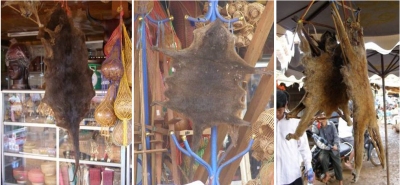 |
| Figure 7. The two Asian small-clawed otter skins and Pygmy loris samples were on sale for traditional medicine purposes at three different wildlife-shops in Banlung market |
Camera Traps
None of Camera traps recorded any otters or other wildlife species. The two Cam Trakker films were damaged by water and the three Reconyx camera traps only recorded activity when we tested them. Moreover, one camera trap was disturbed by human activities, and became pointed away from the sprainting site. However, one photo of an Asian small-clawed otter was recorded in this area in 2008 by a camera trap set by another Conservation International team at Kasap stream (Figure 8).
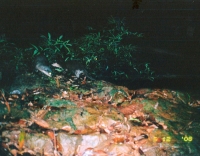 |
| Figure 8. A photo of a group of Asian small-clawed otter was recorded by Camera trap in 2008 by CI team at Kasap stream. |
DISCUSSION
Tracks and spraints were found in the study areas and were identified as coming from Asian small-clawed otters. Moreover, this species was previously recorded by camera trap at Kasap stream, northeastern Cambodia (Hon, 2008) where the study was conducted. According to the result from line transect surveys, 73% of otter signs (sprainting sites and grooming sites) were found at Tankin stream and 27% found at Kasap stream. Kasin and Kapin stream was ignored during the study.The habitat of Asian small-clawed otters was found to be small fresh water streams surrounded by evergreen-forest and secondary forest, or parts of those stream contained old indigenous farmland. Many studies have found that the typical habitats of Asian small-clawed otter are freshwater, swamps, forested rivers, and mangrove forest, stream, lake, rice paddies, and even high in the mountain (Shrestha, 1997; Muller, 1839 cited in Hussain and de Silva, 2008; Kanchanasaka et al., 1998; Kruuk, 2006). The Asian small-clawed otter preferred to live under the canopy more than in the open areas, as the Asian small-clawed otter dislike the bare and open areas that do not offer any shelter (Melisch et al., 1996, cited in Hussain and de Silva, 2008).
Analysis of spraint composition indicated that the diet of the Asian small-clawed otter in this region contained many more crabs remains than fish. Lekagul and McNeely 1988 state that they eat less fish than other otters and rely more on molluscs and crabs. Many other studies comment on its reliance on non-fish aquatic organisms such as crabs and molluscs, insect and small fish such as gouranmis and catfish (Medway, 1983; Wayre, 1978). Moreover, Asian small-clawed otter also eats frogs, small birds and the occasional octopus (Heap et al., 2008) including invertebrates, fish, snakes, amphibians and snails (Maslanka and Crissey, 2002). This otter species was already known as mainly a crab-eater, (Foster-Turley, 1992), followed by snails, fish, and snakes (Kanchanasaka, 2004).
There is little documentation about threats to Asian small-clawed otters in Cambodia (Hon, 2008). However, based on interviews documenting changes in abundance, and apparent high hunting pressures, it seems very likely that populations of Asian small-clawed otters are declining in the region. Most of the Asian small-clawed otters reported were killed by traps and dogs in the study areas, because the otters seem to prefer to live in small streams, and rice paddies feeding on the many small crabs there (Kruuk, 2006), where those habitats are closely to the indigenous people farms and settlements. Through direct observation around the study sites, most parts of evergreen-forest were cleared for farming (shifting cultivation) and settlement, particularly the forests near the stream, which comprise Asian small-clawed otter habitats. The indigenous people’s main livelihoods are as farmers, hunters, and fishermen, so they often go into forest by walking along the streams in order to catch fish, hunt wildlife (pangolin, turtle, dragon monitor, water monitor), and collect honey, and use poisonous leaves to kill fish resources along the streams. Many fresh tracks of both humans and dogs, and fishing nets were found during the survey. These activities suggest the Asian small-clawed otters were heavily threatened by human being activities. Other studies also found that the main threats to otters to be habitat destruction (Hussain and de Silva, 2008), skin demand for both traditional medicine and the wildlife trade (Nguyen et al., 2002), and over-fishing. Additionally, Asian small-clawed otters get killed when they were caught in fishing traps (Kanchanasaka, 2004). This species is currently considered to be Vulnerable by the IUCN Otter Specialist Group’s Red List Authority because of an inferred future population decline due to habitat loss and exploitation (Hussain and da Silva, 2008).
No otters or other wildlife species were recorded by camera traps during the study period, although most camera traps were set up in front of the fresh spraints of Asian small-clawed otters. This period in northeastern Cambodia coincides with the heaviest rain, especially the period of our study from May to June. During the study period, we found that the water level at Kasap can increase by an average of 2 meters and at Tankin stream can increase by an average of 1 meter after rains of more than 2 hours. Consequently, all the camera traps had to be set up higher than one would typically use to trap otters in order to escape water damage. It is therefore probably impractical to set camera traps aiming to record otters in the wet season, especially on streams where the water level changes quickly like Kasap and Tankin streams.
CONCLUSION
In summary, we definitely established that Asian small-clawed otters are found in the study area located on the border between Stung Treng and Ratatanakiri provinces in northeastern Cambodia. This is the first recent, reliable record of this species’ distribution in Cambodia.
We found that the habitat used was small fresh water streams surrounded by evergreen-forest, secondary forest and indigenous farmland, abandoned under the shifting cultivation system. Both streams surveyed have similar habitat, and the areas where otter spraint was found are dominated by three species of tree: Bridelia ovata, Homonoia riparia, and Barringtonia acuiangula. The streams averaged about 5.72 m in width, with slow water current, and depth averaging 51.18 cm. The streams where the Asian small-clawed otter signs were found are rich in food resources, especially crabs.
Typically, for sprainting sites,the otters seem to use substrates which are a mixture of soil, grass, rocks and sand, strongly preferring sand, under canopy cover rather in the open, and on average 1.78m from the water’s edge. Large piles of sprainting are created as all group members use the same site. There are two main components in the spraint: 85% crab and the rest apparently fish or unidentifiable debris.
The main threats to Asian small-clawed otter in the study area are: hunting for skin trade, food, traditional medicine and habitat disturbance, especially by human activities. The indigenous people in the study area use many tools for hunting otter such as traps, domestic dogs, fishing hooks and guns. From 1990 to 2009, 21 otters were killed for skins in this area alone, and we found seven Asian small-clawed otter skins for sale in Banlung wildlife-shop, Ratanakiri province. These skins were bought by people who believe they can cure illness, especially in pregnant women. The local wildlife traders buy otter skins at a very high price compared to local incomes and as the main livelihoods of local people are farming, hunting and fishing, and since they often travel along streams when hunting, otters are readily met by chance and killed.
We believe that the population of Asian small-clawed otters in Cambodia is under threat and declining, and that further surveys should urgently be done to establish whether this is the only remaining population, in the country, the area populated, and an estimate made of the current population size, with a view to mobilizing conservation effort to protect these animals.
Acknowledgements - Conservation International-Cambodia and IUCN Otter Specialist Group provided the funding for this study. We express our sincere gratitude to Mr. Seng Bunra, Annette Olsson, Carol Bennetto, Lesley Wright, Dr. Nicole Duplaix, Arno Christian, Mr. Pov Somanak, Mr. Heng Sokrith, Ben Rawson, Mr. Chey Koulang, Clarisse Reiter, Mr. Dong Tangkor and Mr. Cheap Thom for guidance and addition on this paper. Moreover, we would like also to thank to Mr. Von Monnin dean of Faculty of Forestry Science, Royal University of Agriculture as well as to Mr. Chou Sophak, Virachey National Park Director and Mr. Khem Rong Den, Deputy Park Director, Department of Environment and Forestry Administration in Ratanakiri province for supporting the rangers and permission to study in this area
REFERENCES
Anoop, K.R., Hussain, S.A. (2004). Factors affecting habitat selection by smooth-coated otter (Lutra perspicillata) in Kerala, India. J. Zool. 263: 417—423.
Clavero, M., Prenda, J., Delibes, M. (2004): Influence of spatial heterogeneity on coastal otter (Lutra lutra) prey consumption. Ann. Zool. Fennici 41: 551-561
Forestry Administration (2006). Global Information System Map data.
Foster-Turley, P. (1992). Conservation aspect of the ecological of Asian small-clawed otter and Smooth-coated otter on the Malay Peninsula. IUCN Specialist Group Bull, 7: 26-29.
Foster-Turley, P. S. Macdonald, Mason, C.F. (1990). Otter and Action Plan for Conservation. IUCN Gland, Switzerland.
Harris, C. J. (1968). Otters a Study of the Recent Lutrinae, Weidenfeild & Nicolson, London.
Heap, C.J., Wright, L.C., Andrews, L. (2008). Summary of Husbandry Guidelines for Asian Small-clawed Otter in Captivity. IUCN/SSC Otter Specialist Group: Otters in Captivity Taskforce
.
Hon, N. (2008). Otter Research at Virachey National Park. Unpublished Report for Conservation International.
Hon, N., Dong, T. (2008). Otter Research at Peam Krosoap Wildlife Sanctuary, Kok Kong Province. Unpublished Report for Conservation International.
Hussain, S.A., de Silva, P. (2008). Aonyx cinereus: In IUCN 2008. 2008 IUCN Red List of Threatened species.
[Available from http://www.iucnredlist.org/details/44166/0 Downloaded on 28 July 2009]
Kanchanasaka, B. (2004). Status and distribution of the hairy-nosed otter (Lutra sumatrana). Poster, Ninth International Otter Colloquium, Frostburg, MD, USA.
Kanchanasaka, B. (2001). Tracks and Other signs of the Hairy-Nosed Otter (Lutra sumatrana). Wildlife Research Division, Forest Technical Bureau, Royal Forest Department, Paholoyothin rd., Chatujak, Chatujak, 10900 Bangkok, Thailand.
Kanchanasaka, B., Simcharoen, S., Than, U.T (1998). Carnivores of Thailand, South East Asia. Endangered Species Unit, WWF Thailand.
Kanchanasaka, B. (1997). Ecology of the otter in the Upper KhaweYai River, Thung Yai Narasuan Wildlife Sanctuary, Thailand. Nat. Hist. Bull. Siam. Soc. 45, 79 – 92.
Kruuk, H. (2006). Otters, ecology, behaviour and conservation. Department of Zoology, Aberdeen, Scotland. Oxford University Press. p. 23, 52,117.
Kruuk, H. (1995). Wild otters: Predation and populations. Oxford University Press, Oxford.
Kruuk, H., Kanchanasaka, B, O’Sullivan, S.,Wanghongsa, S. (1993). Identification Taracks and Other Sign of Three Species of Otter, Lutra lutra, L. Perspicillata and Aonyx cinereus in Thailand, Nat. Hist. Siam Society. 41: 23.30.
Lekagul, B., McNeely, J. (1977). Mammals of Thailand, Kivrushna, Bangkok, Thailand.
Maslanka, M.T., Crissey, S.D. (1998). Nutrition and Diet. In: The Asian Small Clawed Otter Husbandry Manual. Columbus Zoological Gardens, Columbus, OH.
Medway, Lord (1969). The Wild Mammals of Malaya. Oxford: Oxford University Press, Oxford
Nguyen, X. D, Pham, T. A., Nguyen, T. S (2002). Result of the IOSF Funded Otter Survey in Vo Doi Natural Reserve, Tran Van Thoi and U Minh Hi Fishery-Forestry Enterprise, Southern Vietnam. IOSF, Isle of Skye, Scotland
Olsson, A., Heng, S., Hon, N., Peove, S., Nop, N. (2007). Cambodia Otter Research and Conservation Project. Presentation at Xth International Otter Colloquium, Oct 10-16th 2007, Hwacheon, South Korea.
Poole, C.M. (2003). The first records of Hairy-nosed Otter Lutra sumatrana from Cambodia with notes on the national status of three other otter species. Nat. Hist. Bull. Siam Soc. 51: 273-280.
Shrestha, T.K. (1997). Mammals of Nepal, with reference to those of India, Bangladesh, Bhutan and Pakistan. Kathmandu, Nepal.
Wayre, P. (1978). The status of otters in Malaysia, Sri Lanka and Italy. Pp152-155 in Otters (N. International Union for the Conservation of Nature, Gland, Switzerland.
Webb, J.B. (1975). Food of the otter Lutra lutra on the Somerset levels. J. Zool. (Lond.) 177: 486-491.
Wright. L.C., Olsson, A., Kachanasaka, B. (2008). A working review of the hairy-nosed otter (Lutra sumatrana). IUCN Otter Spec. Group Bull. 25(1): 38-59
Résumé : Le Régime Alimentaire et l’Habitat des Loutres Cendrées dans le Nord-Est du Cambodge
Nous avons établi la présence de la loutre cendrée, Aonyx cinereus, dans le nord-est du Cambodge. L’étude a été menée entre mai et juin, 2009 dans deux rivières d’eau douce entre les provinces de Stung Treng et Ratanakiri au nord-est du Cambodge. L’habitat principal des loutres cendrées semble être les ruisseaux d’eau douce cernés par des forêts de conifères tropicales, des forêts secondaires ou des endroits de déprise agricole avec végétation le long des berges (couvert d'herbe à 20%, de roche à 20%, de sable à 20% et de terre à 40%) où se trouve d’abondante sources d’alimentation, surtout de crabes. Les sites de dépôts des épreintes préfères des loutres cendrées sont sous canopée au lieu de ciel ouvert, en moyenne leurs épreintes se situent à 1.78 metres de l’eau. Cette espèce semble déposer ses épreintes en grand tas (en moyen 33.11cm en largeur et 43.52 cm en longueur), les épreintes comportent 85% de crabes, 10% de poissons, et 5% non identifié. Les menaces principales pesant sur les populations de loutre cendrée où nous avons mené nous recherches sont la chasse pour la viande de brousse, la médecine traditionnelle, et les peaux pour fournir le commerce de faune ainsi que la perturbation de leur habitat et la surpêche.
Revenez au dessus
Resumen: Alimento y Hábitat de la Nutria Asiática de Garra Pequeña en el Noreste ee Cambodia
Hemos establecido la existencia de nutrias asiáticas de garra pequeña (Anois cinereus) en el noreste de Cambodia. Este studio fué conducido entre Mayo y Junio de 2009 en dos corrientes de agua dulce de la frontera entre las provincias de Stung Tren y Ratanakiri al nordeste de Cambodia. El hábitat de las nutrias asiáticas de garra pequeña parece icluir pequeñas corrientes de agua dulce con vegetación rivereña (20% hierba, 20% roca, 20% arena y 40% suelo), rodeadas bósques perennifolios, bósques secundarios o tierras agrícolas abandonadas con amplios recursos en alimentos, especialmente cangrejos. Las nutrias asiáticas de garra pequeña prefieren depositar sus excrementos bajo el dosel del bosque y no a cielo abierto, en promedio a 1.78 m del agua. Esta especie parece producir en sus lugares de deposición grandes pilas de heces (33.11 cm de ancho y 43.52 cm de largo en promedio) que incluyen 85% de cangrejo, 10% de pescado y 5% de desechos no identificados. Los mayores riesgos para la población de las nutrias asiáticas de garra pequeña en el área de estudio son la caza para alimento y medicina tradicional, así como la piel para comercio; perturbación del hábitat natural y pesca excesiva.
Vuelva a la tapa
